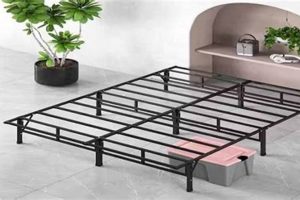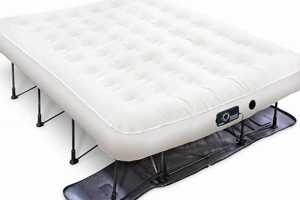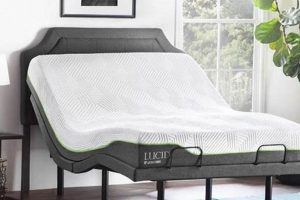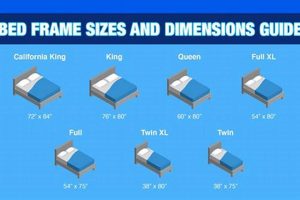A supportive structure designed to elevate and encase a sleep surface. These platforms provide essential support, preventing sagging and ensuring proper alignment for the sleeper. Examples include metal bed frames, wooden platform beds, and adjustable bases.
The utilization of such support systems is crucial for maintaining the integrity of the sleep surface, extending its lifespan, and optimizing comfort. Historically, simple bed frames evolved from rudimentary ground coverings to elaborate pieces of furniture, reflecting changing societal needs and aesthetic preferences. The correct support system is vital for achieving quality sleep, which is essential for physical and mental well-being.
This discussion will now delve into the various types available, the materials used in their construction, and the factors to consider when selecting the appropriate support system for individual needs.
Selecting a Bed Support Structure
Choosing the correct bed support structure is a critical component of a comfortable and supportive sleep system. Careful consideration of several factors will ensure optimal performance and longevity.
Tip 1: Assess Mattress Compatibility: Different mattresses require different levels of support. Memory foam mattresses, for example, typically benefit from solid or closely spaced platforms to prevent sagging. Innerspring mattresses may function well with traditional slatted supports, provided the slats are adequately spaced and reinforced.
Tip 2: Measure Room Dimensions: Before purchasing, accurately measure the available space in the bedroom. Account for the overall dimensions of the support structure, including any headboard or footboard, to ensure it fits comfortably within the designated area and allows for adequate movement around the room.
Tip 3: Consider Weight Capacity: Evaluate the combined weight of the mattress and occupants. Verify that the chosen support structure’s weight capacity exceeds this total to prevent structural failure and ensure long-term durability. Exceeding weight limits can void warranties and compromise safety.
Tip 4: Evaluate Material Quality: Examine the materials used in the construction of the support structure. Solid wood, reinforced steel, and high-density plastics are generally indicative of higher quality and increased longevity. Particleboard and low-grade metals may be more susceptible to damage and premature wear.
Tip 5: Check for Adequate Support: Ensure that the support system provides adequate and even support across the entire mattress surface. Sagging or uneven support can lead to discomfort, poor spinal alignment, and reduced mattress lifespan. Closely spaced slats or a solid platform are generally preferable for consistent support.
Tip 6: Consider Storage Needs: Evaluate whether under-bed storage is desired. Platform beds with built-in drawers or elevated frames that allow for storage containers can be beneficial for maximizing space, particularly in smaller bedrooms. Ensure adequate clearance and accessibility for storage items.
Tip 7: Examine Assembly Requirements: Review the assembly instructions and required tools before purchasing. Complex assembly processes can be time-consuming and frustrating. Opt for a support structure with straightforward assembly or consider professional assembly services.
Selecting the appropriate support structure involves careful assessment of mattress type, room dimensions, weight capacity, material quality, support design, storage requirements, and assembly considerations. Prioritizing these factors will result in a comfortable, durable, and supportive sleep environment.
The following sections will explore specific types and their unique features.
1. Support
Support constitutes the foundational purpose of a bed’s frame. The structure functions primarily to elevate and uphold the mattress, ensuring it maintains its intended shape and provides consistent comfort. Inadequate support from a bed frame results in mattress sagging, uneven weight distribution, and ultimately, a compromised sleep surface. A slatted frame with widely spaced, flimsy supports, for example, fails to adequately bear the weight of the mattress and sleeper, leading to premature wear and tear. Conversely, a robust platform bed with solid construction provides uniform support, extending the lifespan of the mattress and enhancing the overall sleep experience.
The material composition and design of a bed frame directly influence the level and quality of support it offers. Steel frames with center support legs provide reinforcement against bowing and breakage, particularly crucial for larger mattresses. Wooden platform beds with a solid or closely spaced slatted surface offer superior support for memory foam mattresses, preventing the material from conforming excessively and losing its intended density. Adjustable bed bases, another type, offer customized support and positioning, providing relief for specific medical conditions. The selection of an appropriate frame directly correlates to the long-term performance and comfort derived from the mattress.
In summary, the relationship between support and the bed frame is one of direct causality. A well-designed, structurally sound frame provides the necessary support for a mattress to function optimally, contributing to improved sleep quality and extended mattress lifespan. Neglecting this crucial aspect leads to compromised comfort, reduced durability, and potential health implications. Understanding the interplay between frame design and support is therefore essential for selecting a bed that meets individual needs and ensures a restorative sleep environment.
2. Size Compatibility
Size compatibility between a bed support structure and the sleep surface it is intended to hold is not merely a matter of aesthetics; it is a fundamental requirement for both structural integrity and sleep quality. Deviations from standard dimensions or mismatched pairings can lead to compromised support, reduced mattress lifespan, and potential safety hazards.
- Standard Dimensions and Mattress Sizes
Mattresses adhere to established size standards (Twin, Twin XL, Full, Queen, King, California King). Bed support structures are manufactured to correspondingly match these dimensions. A failure to align with these standards results in either a mattress that overhangs the support or one that shifts excessively within the frame. This misalignment compromises edge support and creates instability.
- Internal Frame Dimensions and Mattress Fit
The internal dimensions of the bed support structure must precisely accommodate the mattress. Deviations of even an inch can introduce problems. A frame that is too small will compress the mattress, potentially damaging internal components. A frame that is too large will allow the mattress to shift, leading to uneven wear and reduced support.
- Headboard and Footboard Considerations
The presence of a headboard or footboard further complicates size compatibility. The mattress must fit snugly within the confines of these elements. Insufficient clearance between the mattress and the headboard or footboard can impede movement and cause discomfort. Conversely, excessive clearance creates an unsightly gap and diminishes the overall aesthetic appeal of the bed.
- Platform Bed Considerations
Platform beds, characterized by their integrated support surface, demand precise size matching. The mattress rests directly on the platform, eliminating the need for a separate box spring. Any size discrepancy will result in an uneven sleeping surface and compromised support. The platform must be perfectly sized to prevent sagging or instability.
In summary, size compatibility is a crucial, multi-faceted consideration when selecting a bed support structure. Adherence to standard dimensions, precise internal frame measurements, consideration of headboard and footboard clearances, and careful attention to platform bed sizing are all essential for ensuring optimal support, extending mattress lifespan, and promoting a safe and comfortable sleep environment. A misaligned size creates unnecessary stress and compromises the functionality of the support.
3. Material Durability
Material durability, in the context of the structural support system for mattresses, directly influences the lifespan, stability, and long-term performance of the overall bed. The materials utilized in the construction of the frame dictate its resistance to stress, wear, and environmental factors, ultimately affecting the quality of sleep experienced.
- Wood: Strength and Stability
Wood offers aesthetic appeal and structural support, but durability varies. Solid hardwoods like oak or maple provide superior resistance to warping and breakage compared to softwoods like pine. Kiln-dried wood minimizes moisture content, reducing the likelihood of future warping or cracking. The type and treatment of wood directly correlate with the frame’s ability to withstand weight and movement over time.
- Steel: Strength and Longevity
Steel frames, particularly those constructed from heavy-gauge steel, provide exceptional strength and resistance to bending or deformation. Powder-coated finishes enhance steel’s resistance to corrosion and scratching, further extending its lifespan. Welded joints contribute to overall structural integrity, preventing loosening or failure under stress. The gauge and coating of steel are critical determinants of long-term durability.
- Plastics and Composites: Lightweight and Resistant
High-density polyethylene (HDPE) and composite materials offer lightweight alternatives with inherent resistance to moisture and insect damage. While generally less strong than wood or steel, these materials can be suitable for platform beds or support components in conjunction with metal frames. UV stabilizers prevent degradation from sunlight exposure, enhancing their durability in well-lit environments. The specific formulation and reinforcement of plastics dictate their load-bearing capacity.
- Fasteners and Hardware: Connection Strength
Bolts, screws, and other fasteners play a crucial role in maintaining the structural integrity of the assembled frame. High-quality steel hardware with corrosion-resistant coatings prevents rust and ensures secure connections over time. The diameter, thread pitch, and material of fasteners directly influence their ability to withstand stress and vibration. Regular inspection and tightening of hardware are essential for maintaining frame stability.
The selection of durable materials is paramount for ensuring the longevity and stability of a support structure. Whether wood, steel, plastic, or a combination thereof, the material properties dictate the frame’s ability to withstand the stresses of daily use and maintain its intended function over an extended period. Careful consideration of material composition, treatment, and construction techniques is essential for selecting a support system that provides lasting support and comfort.
4. Assembly Simplicity
Assembly simplicity, in the context of a mattress frame, represents a critical factor influencing consumer satisfaction and overall product value. The ease with which a support structure can be assembled directly correlates to reduced setup time, minimized frustration, and a greater likelihood of correct installation. A complex assembly process can lead to misaligned components, weakened structural integrity, and potential safety hazards, ultimately undermining the frame’s primary function. Examples of frames with simple assembly often include those utilizing a minimal number of parts, clear and concise instructions, and requiring only basic tools, such as an Allen wrench or screwdriver. The absence of these features often results in protracted setup times and the need for professional assistance.
The practical implications of assembly simplicity extend beyond mere convenience. A straightforward assembly process reduces the risk of errors that could compromise the frame’s structural integrity. For instance, a frame requiring the precise alignment of multiple screws without clear guidance may result in an unstable platform prone to wobbling or collapse. Conversely, a frame designed with intuitive interlocking components and readily accessible hardware minimizes the potential for such errors, ensuring a secure and stable foundation for the mattress. The presence of pre-drilled holes, labeled parts, and step-by-step visual aids further contribute to a simplified assembly experience.
In conclusion, assembly simplicity is an integral component of a well-designed mattress frame, impacting not only the initial setup process but also the long-term stability and safety of the product. Complex assembly procedures can lead to structural compromises and user dissatisfaction, whereas a straightforward design promotes ease of use and ensures a secure foundation for the mattress. The challenges associated with complex assembly highlight the importance of clear instructions, intuitive design, and minimal hardware in achieving a positive consumer experience. Ultimately, selecting a frame with assembly simplicity in mind contributes to a more functional and enjoyable sleep environment.
5. Style
The stylistic element of a mattress frame extends beyond mere aesthetics; it serves as a crucial component in harmonizing the bedroom’s overall design and reflecting individual preferences. The choice of a particular style can significantly influence the ambiance of the room and contribute to a sense of personal expression. It moves beyond basic functionality to become a design statement within the living space.
- Material and Finish Coordination
The material and finish of the frame should complement existing furniture and dcor. A rustic wooden frame pairs well with a farmhouse-style bedroom, while a sleek metal frame may better suit a modern, minimalist setting. The finish, whether a natural wood stain, a painted surface, or a polished metal, contributes significantly to the overall aesthetic. Mismatched materials or finishes can disrupt the visual harmony of the room.
- Headboard Design and Integration
The headboard is often the focal point of the bed. Its design, whether simple or ornate, significantly impacts the style of the frame and the bedroom as a whole. A tall, upholstered headboard evokes a sense of luxury, while a low-profile wooden headboard projects a more contemporary feel. The integration of the headboard with the rest of the frame should be seamless and visually appealing.
- Frame Profile and Silhouette
The overall profile and silhouette of the frame contribute to its stylistic impact. A platform bed with a low profile creates a sense of spaciousness and modernity, while a traditional bed frame with a high profile and intricate detailing conveys a more formal and classic aesthetic. The shape and lines of the frame influence the visual weight and presence of the bed within the room.
- Color Palette and Contrast
The color of the frame should harmonize with the room’s color palette or provide a deliberate contrast for visual interest. A neutral-colored frame blends seamlessly into the background, allowing other elements of the room to take center stage, while a brightly colored frame can serve as a focal point and add personality to the space. Careful consideration of color theory ensures a cohesive and visually pleasing design.
In summary, the stylistic considerations for a mattress frame are multifaceted, encompassing material and finish coordination, headboard design and integration, frame profile and silhouette, and color palette and contrast. A well-chosen frame enhances the overall aesthetic of the bedroom, reflecting individual preferences and contributing to a comfortable and visually appealing sleep environment. The careful selection of these elements results in a bed that is not only functional but also a stylish centerpiece of the room.
6. Weight Capacity
Weight capacity represents a critical, often overlooked, specification when selecting a support structure for a mattress. Ignoring this factor can lead to structural failure, compromised comfort, and potential safety hazards, thereby negating the benefits of even the highest-quality mattress.
- Static Load Distribution
Static load refers to the constant weight exerted on the frame by the mattress and the occupants during periods of rest. Bed frames are engineered to withstand a specific static load, distributed evenly across the support surface. Exceeding this limit can cause bowing, bending, or breakage of the frame’s components. For instance, a frame rated for 500 pounds may fail if supporting a 300-pound mattress and two occupants weighing 250 pounds each, leading to instability and potential damage.
- Dynamic Load Considerations
Dynamic load encompasses the forces exerted on the frame during movement, such as sitting, repositioning, or engaging in activities on the bed. These dynamic forces can significantly exceed the static load, placing additional stress on the frame’s joints and support structures. A frame with an adequate static weight capacity may still fail under dynamic loads if its construction is not sufficiently robust. Therefore, a margin of safety should be considered when assessing weight capacity, accounting for potential dynamic forces.
- Material Properties and Weight Rating
The materials used in the construction of the frame directly influence its weight capacity. Steel frames, particularly those utilizing heavy-gauge steel, generally offer higher weight ratings compared to wooden frames. The type and grade of wood, as well as the joinery techniques employed, also affect the frame’s ability to withstand weight. Manufacturers typically provide weight ratings based on the material properties and structural design of the frame. It is imperative to consult these ratings to ensure compatibility with the intended load.
- Consequences of Exceeding Capacity
Exceeding the stated weight capacity of a bed frame can result in a range of adverse consequences, including structural damage, premature wear, and potential injury. Bent or broken frame components can compromise the stability of the bed, leading to discomfort and poor sleep quality. In extreme cases, frame failure can result in the mattress collapsing, posing a safety hazard to the occupants. Furthermore, exceeding the weight capacity often voids the manufacturer’s warranty, leaving the consumer responsible for repair or replacement costs.
Therefore, careful consideration of weight capacity is essential when selecting a bed frame. Assessing the combined weight of the mattress and occupants, accounting for dynamic forces, and verifying the frame’s weight rating are crucial steps in ensuring a safe, comfortable, and durable sleep environment. A frame with an inadequate weight capacity compromises both the mattress and the well-being of those using it.
7. Under-bed clearance
Under-bed clearance, as a design attribute of a mattress frame, dictates the available vertical space between the floor and the bottommost support structure of the bed. This dimension has practical implications for storage capacity, accessibility for cleaning, and the overall aesthetic of the bedroom. A frame with minimal clearance offers limited or no storage options and may impede vacuuming or sweeping underneath the bed. Conversely, a frame with substantial clearance provides ample space for storage containers or other items, facilitating organization and maximizing the utilization of available space. The height of the clearance must be carefully considered in relation to the height of items intended for storage.
The consideration of under-bed clearance impacts both functionality and visual aspects. For example, platform beds frequently have low under-bed clearance, emphasizing a minimalist design but restricting storage options. Traditional bed frames with legs often provide more substantial clearance, allowing for the accommodation of storage bins or boxes. Adjustable bed frames may offer variable clearance depending on their configuration. Increased clearance enhances the perceived spaciousness of a room, preventing the bed from visually dominating the area. In environments where maximizing storage within a small space is crucial, a frame with high under-bed clearance is a practical solution. Failure to account for clearance can result in limited storage opportunities and difficulties in maintaining cleanliness beneath the bed.
In summary, under-bed clearance is a critical design element in support structure, directly impacting storage potential, cleaning accessibility, and the overall visual impression of the bedroom. The selection of a frame with appropriate clearance requires careful evaluation of individual storage needs, room dimensions, and aesthetic preferences. Proper consideration of this design attribute contributes to a more organized, functional, and visually appealing living space. The relationship demonstrates how a seemingly minor feature can significantly influence utility.
Frequently Asked Questions
This section addresses common inquiries regarding bed support structures, providing concise and informative answers to enhance understanding and facilitate informed decision-making.
Question 1: What is the expected lifespan of a typical bed support structure?
The lifespan varies significantly depending on material composition and usage intensity. A well-constructed steel frame can last for decades, while wooden frames may exhibit signs of wear sooner, particularly if exposed to humidity or excessive weight. Regular inspection and maintenance can extend the lifespan of any frame.
Question 2: How does the choice of a frame impact mattress warranty?
Many mattress warranties stipulate the use of a compatible and structurally sound support system. Using an inappropriate frame, such as one with inadequate support or incorrect dimensions, can void the warranty, leaving the owner responsible for repair or replacement costs.
Question 3: Are adjustable bed bases compatible with all mattresses?
Adjustable bases are not universally compatible. Innerspring mattresses, for example, may not conform well to the adjustable contours, potentially damaging the internal coils. Memory foam and latex mattresses are generally better suited for adjustable bases due to their flexibility.
Question 4: What are the key differences between platform beds and traditional frames with box springs?
Platform beds eliminate the need for a box spring by providing a solid or closely slatted support surface. This often results in a lower profile and a firmer feel. Traditional frames require a box spring to provide support and elevation for the mattress, offering a more traditional aesthetic.
Question 5: How does under-bed storage affect the structural integrity of the support structure?
Excessive weight from under-bed storage can strain the support structure, potentially leading to sagging or breakage. It is important to distribute weight evenly and avoid exceeding the frame’s stated weight capacity. Reinforcing the frame may be necessary if substantial under-bed storage is anticipated.
Question 6: What are the signs that a bed support structure needs to be replaced?
Visible signs of damage, such as cracks, bends, or broken components, indicate the need for replacement. Squeaking, wobbling, or uneven support also suggest structural compromise. Ignoring these signs can lead to discomfort, poor sleep quality, and potential injury.
The selection of a compatible and structurally sound bed support structure is crucial for maintaining mattress integrity, optimizing sleep quality, and ensuring long-term durability. Understanding these key considerations facilitates informed decision-making.
The following section will explore advanced support structure technologies.
The Enduring Importance of a Quality Mattress Support System
This exploration has underscored the multifaceted role of the frame for mattress. Beyond simple elevation, the support system profoundly impacts mattress lifespan, sleep quality, and overall bedroom aesthetics. Key considerations include material durability, size compatibility, assembly simplicity, weight capacity, stylistic integration, and available under-bed clearance. Each factor contributes to the functionality and longevity of the complete sleep system.
Therefore, the selection of a suitable frame for mattress represents a significant investment in long-term well-being. Continued advancements in materials and design promise even greater levels of customization and support. Individuals are encouraged to carefully evaluate their specific needs and preferences to ensure a sound and restful sleep experience for years to come. A properly chosen frame is not merely a piece of furniture, but a critical foundation for restorative sleep.


![Best Queen Futon Frame and Mattress Sets: [Year] Guide Organic & Natural Mattress Buyer’s Guide: Non-Toxic Sleep Solutions Best Queen Futon Frame and Mattress Sets: [Year] Guide | Organic & Natural Mattress Buyer’s Guide: Non-Toxic Sleep Solutions](https://mattressworldpa.com/wp-content/uploads/2025/07/th-3093-300x200.jpg)



![Best Blow Up Air Mattress with Frame [Guide] Portable Beds Organic & Natural Mattress Buyer’s Guide: Non-Toxic Sleep Solutions Best Blow Up Air Mattress with Frame [Guide] Portable Beds | Organic & Natural Mattress Buyer’s Guide: Non-Toxic Sleep Solutions](https://mattressworldpa.com/wp-content/uploads/2025/07/th-3089-300x200.jpg)
